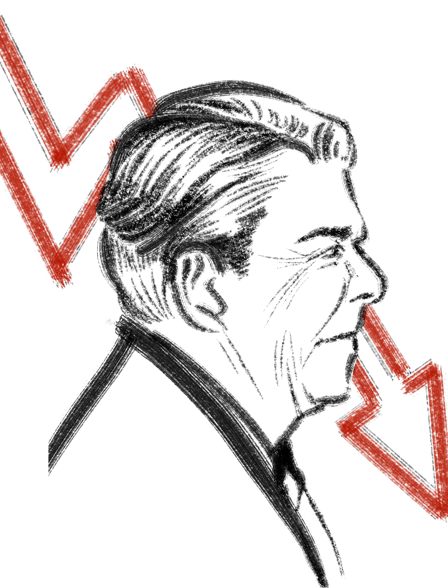Why (almost) everything is Ronald Reagan’s fault
How today’s extreme class disparity and economic instability can be traced back to the 1980s
In the ‘80s, the United States’ 40th president Ronald Reagan pushed social and economic plans that laid the groundwork for Donald Trump’s presidencies and growing social inequalities.
Inaugurated in 1981, the actor-turned-politician left a permanent stain on America, from his refusal to address the HIV/AIDS epidemic, leading to the deaths of thousands, to his economic policies strengthening class divides.
Still revered by modern-day conservatives, “Reaganomics,” based in supply-side economics, is an economic model based on cutting taxes for corporations and the highest-earners as well as deregulating industry, slowing spending on social programs and putting a higher emphasis on free trade. The reason: the belief that it would stimulate the economy by encouraging the rich to invest and having the money “trickle-down” to the consumers.
“Reaganomics” was mostly based on the theories of economist Arthur Laffer, who served as the chief economist for the US Office of Management and Budget from 1970 to 1972. Known as the father of supply-side economics, he created the Laffer curve, an economic theory outlining the presence of an optimal tax rate and how rising taxes too high can lead to a decrease in government revenue.
Laffer not only had a huge influence on Reagan, but he continues to be a key figure in conservative economic policy to this day. Indeed, he served as Trump’s economic advisor during his first term, with Trump awarding him the medal of freedom in 2019.
Reagan inherited an America suffering from high inflation and unemployment, which he promised to fix with his supply-side economic plan. Early in his first term, Reagan passed the Economic Recovery Tax Act of 1981 (ERTA), cutting taxes for the highest earning Americans by 20 per cent.
He implemented massive cuts to social welfare programs, like federal student loans, and increased military spending. He deregulated healthcare, shifting the financial risks from private insurance providers to hospitals and doctors, which still impacts the system today.
His tight economic policy spurred a short six-month recession from 1981 to 1982. According to the Pew Research Center, 54 per cent of Americans in September 1982 agreed that Reagan’s policies had made their financial situation worse, although many believed it would improve.
As such, despite being known for tax-cutting, Reagan was forced to raise taxes across the board in 1982,1983,1984 and 1987, effectively cutting the intended effect of the ERTA in half. While he managed to lower inflation and unemployment, by the end of his tenure, the government deficit had tripled.
This is not a uniquely American system. “Iron Lady” Margaret Thatcher was the prime minister of the United Kingdom during Reagan’s presidency and implemented similar supply-side policies.
Now, unsurprisingly, researchers have shown that extreme tax cuts for the rich did not greatly impact a country’s gross domestic product. It only served to widen the gap between the lowest and highest earners in a society.
Essentially, it allowed the rich to get richer while gutting the middle class.
It’s simple math: If the government collects less tax revenue from the rich, it must recuperate the money somewhere else, either through taxes to the lower and middle classes or slashes in government spending.
As such, George H. W. Bush raised taxes in 1990 despite famously promising not to do so, in part due to the large deficit Reagan left behind. In 1993, Bill Clinton raised the marginal tax rate for the highest-earning Americans when he took office.
With the “dot-com” recession of 2001 at the start of George W. Bush’s first term, the US went back to Reagan-esque supply-side economic tax cuts. According to the Center on Budget and Policy Priorities, this mainly benefited wealthy Americans.
Data shows that economic and investment growth in the US was lower under supply-side economic policies than in the 1990s.
These conservative economic models have also poisoned the Democratic party which, for decades, has been scrambling to the centre in an attempt to secure votes by pushing neoliberal economic policies.
In a column for PBS News, American economic historian John Komlos demonstrated how the post-tax income of the middle class from 1979 to 2011 barely grew when adjusted for inflation, while the top 1 per cent lined their pockets.
Simply put, the benefit of supply-side economics for everyone but the top 1 per cent is nothing more than a myth, a bedside story Conservative politicians keep peddling to line their own pockets.
Unfortunately, the stories worked, with The Guardian reporting that, in his first term, Trump’s tax-cuts led to billionaires paying less in taxes than the working class.
Researcher David Hope—who wrote a paper analyzing the effects of major tax cuts in 18 countries—said in an article for the London School of Economics and Political Science that he could not find any evidence that Trump’s 2017 tax-cut plan would help fuel the economy.
Trump points to immigrants as the reason why so many Americans are struggling, but the truth is that years of placing corporate greed first have landed everyone in this mess. Trump has, time and time again, implemented policies and cuts to advantage his rich peers while perpetuating harm against marginalized communities in America.
Trump’s most recent inauguration brought the idea of supply-side economics to its logical extreme, with billionaires sitting in the front row while his cabinet members sat behind them. All the while, since he got his foot through the doors of the Oval Office, Elon Musk has been slashing government funding left and right. This was despite his companies benefiting massively from government funding.
The income inequality in the US is the highest of all the G7 countries.
Let this be a cautionary tale.
On this side of the border, populist politician Pierre Poilievre is promising to implement similar economic policies, slashing government budgets, gutting social programs and cutting taxes as solutions to the raising cost of living. It won’t work.
The economic state of a country is much more complex than its tax system. But cutting taxes for the rich and slashing government spending has not only proven itself ineffective in helping the economy, it has shown to only deepen class disparities and inequalities.
It’s not common sense; it’s dangerous.
This article originally appeared in Volume 45, Issue 10, published March 4, 2025.


_600_832_s.png)




